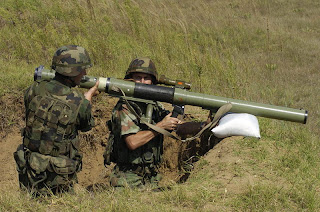Gatling gun
Similar systems are available ranging from 5.56 mm to 30 mm (there was even a 37 mm Gatling on the prototype T249 'Vigilante' AA platform); During the Vietnam War, the 7.62 mm calibre M134 Minigun was created as a helicopter weapon. The M61 Vulcan 20 mm cannon is the most commonly-used member of a family of weapons designed by General Electric and currently manufactured by General Dynamics. In contrast, a five-barreled Gatling gun-style weapon firing 2000 rounds fires 400 per barrel, an acceptable rate of fire. One of the main reasons for the resurgence of the Gatling gun-style design is the weapon's tolerance for continuous high rates of fire. After Gatling guns were replaced by lighter, cheaper blowback-style weapons, the approach of using multiple rotating barrels fell into disuse for many decades. However, Gatling gun-style weapons made a return in the 1940-50s, when weapons with very high rate of fire were needed in military aircraft such as the Lockheed AC-130 gunship and ship-based CIWS. They are also used with lethal effectiveness on USAF AC-47, AC-119 and Lockheed AC-130 gunships, their original high-capacity cargo airframes able to house the items needed for sustained operation. Able to fire 6,000 rounds a minute from a 4,000-round linked belt, the Minigun proved to be one of the most effective non-explosive projectile weapons ever built and is still used in helicopters today. It is a six-barrelled Gatling capable of more than 6,000 rounds per minute, a rate unachievable with a conventional machine gun.
The world's fastest Gatling-style weapon, the 10,000 RPM GSh-6-23 uses a gas-operated drive system. In addition to the benefits mentioned above, many modern systems have the advantage of being externally-driven (as opposed to relying on the energy from fired cartridges). It should however be noted that, although complex mechanically and uncommon, modern systems that derive power from the ammunition do exist. Additionally, certain other stoppages, such as faulty extraction and many feeding-related problems, are eliminated or reduced considerably due to the external power source. This increases their reliability, as cartridge firing failure will not interrupt the operation cycle.

Comments